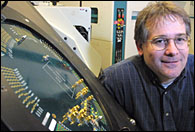Shrink rapt
Microchips keep shrinking as their power expands, putting greater and greater power into laptops and desktops. But certain problems grow along with that capacity, such as the challenge of testing tiny analog chips with bulky equipment. James McGill Professor of Electrical and Computer Engineering Gordon Roberts has come up with a solution.
 Electrical and computer engineering professor Gordon Roberts
Electrical and computer engineering professor Gordon RobertsPHOTO: Owen Egan |
|
"Testing today contributes between 50%-90% of the cost of producing microchips. The reason is the highly sophisticated machinery which is used for testing, which costs anywhere from $1 million to $20 million. Obviously, the industry would prefer not to have to pay those prices." And, he adds, those cost savings would be passed on to consumers of chip-driven products.
After 10 years of R&D, Roberts and his graduate students have developed a powerful and cheaper alternative, which is incorporated in the design stages of analog/mixed signal microchips.
"Testing equipment has, up to now, been external to the chip; we are putting them into the chip. Our testers are microcircuits implemented in silicon and built right into the chip, and which give us the exact same functionality as those million dollar testing machines; in fact, we can do better. The physics tell us that."
The physics of chip testing state that chips will eventually become too small to be tested by bulky equipment, so that Roberts' technology may become the only feasible method.
"Putting the testing equipment on the chip itself does increase the size of the chip a little bit, so there is a price. That is what everyone is nervous about, but the physics are telling us that we have no other choice. That is the key issue.
"As an analogy, consider wanting to look at the size of an atom; you can't see it when you're standing far away from it. You have to be very close to it, if you expect to get reliable information. That's an exaggerated example, but we do know that as microelectronics shrink, they will effectively be farther and farther away from current testing equipment."
In fact, Roberts points out that microchips will reach the range of nanotechnology within 10 years. It is fitting that, as microchips shrink out of sight, testing methods follow suit.
"We have shrunk all that testing equipment by a thousand times in every dimension -- height, width and length -- down to millimetres, a space smaller than a human hair. In fact, we are advocating putting many of these on a chip; that's how small they are. That would give us the advantage of parallelism; since more and more features are on a single chip, there are a lot more things to test. Test equipment running in parallel will save a lot of test time."
Roberts says that this technology became necessary because of the continued miniaturization of chips, which makes large equipment increasingly impractical for testing purposes. Another reason is that the testing equipment has to be replaced at great cost when advances in chip design render it obsolete. Roberts' embedded testing equipment solves both problems.
"Our testers are scalable, which means that they can be adapted to different technologies, because they are almost all digital in design."
Roberts decided to specialize in the testing of analog chips -- the chips which drive, among other things, computer monitors, hard disks and modems -- "because that was the hard problem; that problem was untouched. We were the first to come up with a solution in that area." Testing for digital chips was solved 30 years ago, by IBM.
They did it through painstaking trial and error.
"We designed circuits, and then sent out the designs every few months to chip manufacturers to have them fabricated. Then we tested them to verify if our ideas worked or not; lots of times, they didn't. We went through hundreds and hundreds of designs."
Roberts has obtained several patents on the processes he developed with his research team, and he is working with some private sector companies to commercialize the testing process. In fact, the need for this technology is so great that he says it is on a fast track to the commercial market.
"Some of the techniques we have published up to now are being used in some form or another, but now we have gotten to the point at which the entire problem is under wraps. And I would say that it will be sold to chip manufacturers by the end of this year."

